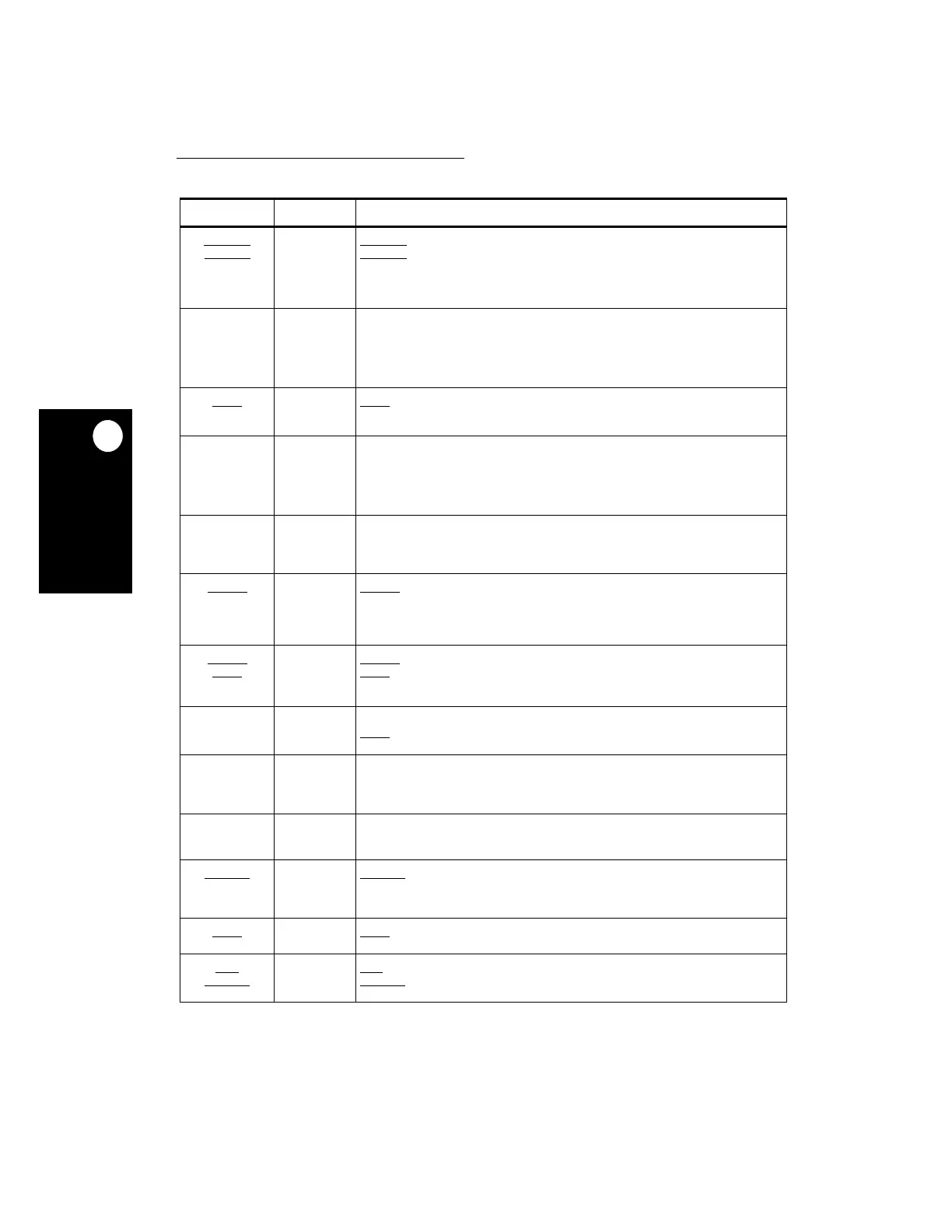External Signals
2-10 MPC823e REFERENCE MANUAL MOTOROLA
EXTERNAL SIGNALS
2
PB[22]
SMSYN2
SDACK2
L1TSYNCB
R9 General-Purpose I/O Port B Bit 22—Bit 22 of the general-purpose I/O port B.
SMSYN2—The serial management controller 2 external sync input pin.
SDACK2
—The SDMA acknowledge 2 output pin that is used as a peripheral
interface signal for IDMA emulation.
L1TSYNCB—The receive sync input for the serial interface time-division multiplex
port B.
PB[19]
L1ST1
LCD_B
R7 General-Purpose I/O Port B Bit 19—Bit 19 of the general-purpose I/O port B.
L1ST1—One of eight output strobes that can be generated by the serial interface.
LCD_B—This is one of the LCD controller’s three extension data bits, which are
used to drive an active LCD panel. When using a 12-bit bus instead of a 9-bit bus,
the LCD_B signal is the least-significant bit of the green 4-bit code. The green portion
of the bus consists of LD[3:5] and LCD_B.
PB[18]
RTS2
L1ST2
P7 General-Purpose I/O Port B Bit 18—Bit 18 of the general-purpose I/O port B.
RTS2
—The Request To Send modem signal for serial communication controller 2.
L1ST2—One of eight output strobes that can be generated by the serial interface.
PB[17]
L1ST3
LCD_C
N7 General-Purpose I/O Port B Bit 17—Bit 17 of the general-purpose I/O port B.
L1ST3—One of eight output strobes that can be generated by the serial interface.
LCD_C—This is one of the LCD controller’s three extension data bits, which are
used to drive an active LCD panel. When using a 12-bit bus instead of a 9-bit bus,
the LCD_C signal is the least-significant bit of the blue 4-bit code. The blue portion
of the bus consists of LD[6:8] and LCD_C.
PB[16]
L1RQA
L1ST4
R5 General-Purpose I/O Port B Bit 16—Bit 16 of the general-purpose I/O port B.
L1RQA—The D-channel request signal for the serial interface time-division multiplex
port A.
L1ST4—One of eight output strobes that can be generated by the serial interface.
PC[15]
DREQ1
L1ST5
L1TXDB
R16 General-Purpose I/O Port C Bit 15—Bit 15 of the general-purpose I/O port C.
DREQ1
—The IDMA channel 1 request input signal.
L1ST5—One of eight output strobes that can be generated by the serial interface.
L1TXDB—The transmit data input signal for the serial interface time-division
multiplex port B.
PC[14]
DREQ2
RTS2
L1ST6
T16 General-Purpose I/O Port C Bit 14—Bit 14 of the general-purpose I/O port C.
DREQ2
—The IDMA channel 2 request input signal.
RTS2
—The Request To Send modem signal for serial communication controller 2.
L1ST6—One of eight output strobes that can be generated by the serial interface.
PC[13]
L1ST7
RTS3
P13 General-Purpose I/O Port C Bit 13—Bit 13 of the general-purpose I/O port C.
L1ST7—One of eight output strobes that can be generated by the serial interface.
RTS3
—The Request To Send modem signal for serial communication controller 3.
PC[12]
L1RQA
L1ST8
T13 General-Purpose I/O Port C Bit 12—Bit 12 of the general-purpose I/O port C.
L1RQA—The D-channel request signal for the serial interface time-division multiplex
port A.
L1ST8—One of eight output strobes that can be generated by the serial interface.
PC[11]
USBRXP
R10 General-Purpose I/O Port C Bit 11—Bit 11 of the general-purpose I/O port C.
USBRXP—Used with USBRXN, this signal is used by the USB to detect a
single-ended zero and the interconnection speed.
PC[10]
TGATE1
USBRXN
P9 General-Purpose I/O Port C Bit 10—Bit 10 of the general-purpose I/O port C.
TGATE1
—The timer1/timer2 gate signal.
USBRXN—Used with USBRXP, this signal is used by the USB to detect a
single-ended zero and the interconnection speed.
PC[9]
CTS2
R8 General-Purpose I/O Port C Bit 9—Bit 9 of the general-purpose I/O port C.
CTS2
—The Clear to Send Modem line for serial communication controller 2.
PC[8]
CD2
TGATE1
N8 General-Purpose I/O Port C Bit 8—Bit 8 of the general-purpose I/O port C.
CD2
—The Carrier Detect Modem line for serial communication controller 2.
TGATE1
—The timer1/timer2 gate signal.
Table 2-1. Signal Descriptions (Continued)
SIGNAL PIN NUMBER DESCRIPTION

